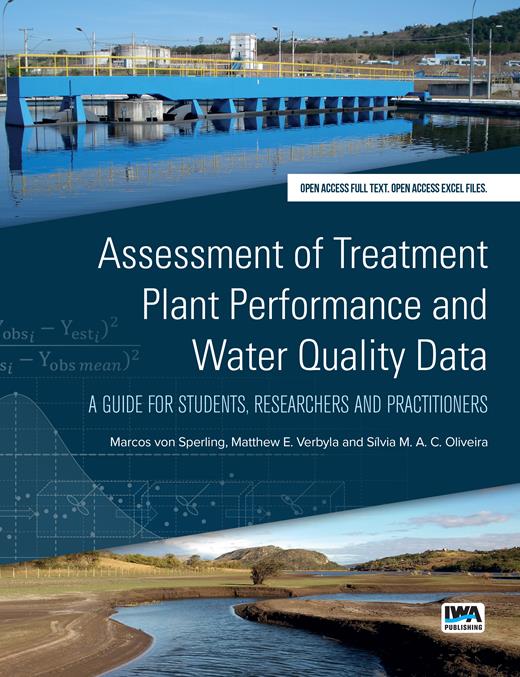Assessment of Treatment Plant Performance and Water Quality Data: A Guide for Students, Researchers and Practitioners
 |
Évaluation du rendement des stations d'épuration et des données sur la qualité de l'eau : un guide à l'intention des étudiants, des chercheurs et des praticiens
livre Jan 2020 ; 668 pages
Aut. Silvia MAC Oliveira & Matthew E. Verbyla & Marcos Von Sperling
Ed. IWA - London
Téléchargeable sous format: PdF
Téléchargeable chez l'éditeur
Page de présentation d'un éditeur
Résumé:
75 feuilles de calcul Excel sont disponibles en téléchargement ici.
Ce livre présente les principes de base pour évaluer la qualité de l'eau et les performances des stations d'épuration d'une manière claire, innovante et didactique, en utilisant une approche combinée qui implique l'interprétation des données de surveillance associées (i) aux processus de base qui se déroulent dans les masses d'eau et dans usines de traitement de l’eau et des eaux usées et (ii) la gestion des données et les calculs statistiques pour permettre une interprétation approfondie des données.
Ce livre est axé sur les problèmes et va de la pratique à la théorie, couvrant la plupart des informations dont vous aurez besoin, telles que (a) l'obtention de données de débit et l'utilisation du concept de chargement, (b) l'organisation de programmes d'échantillonnage et de mesures, (c) relier l'analyse en laboratoire à la gestion des données, (e) utiliser des méthodes numériques et graphiques pour décrire les données de surveillance (statistiques descriptives), (f) comprendre et rendre compte des efficacités d'élimination, (g) reconnaître la symétrie et l'asymétrie dans les données de surveillance (distributions normales et log-normales ), (h) évaluer le respect des objectifs et des normes réglementaires en matière d'effluents et de masses d'eau, (i) faire des comparaisons avec les données de surveillance (tests d'hypothèses), (j) comprendre la relation entre les variables de surveillance (analyse de corrélation et de régression), ( k) réaliser des bilans d'eau et de masse, (l) comprendre les différents taux de chargement appliqués aux unités de traitement, (m) apprendre les principes de la cinétique de réaction et de l'hydraulique du réacteur et (n) effectuer l'étalonnage et la vérification des modèles.
Les concepts majeurs sont illustrés par 92 exemples entièrement élaborés, appuyés par 75 feuilles de calcul Excel téléchargeables gratuitement. Chaque chapitre se termine par une liste de contrôle pour votre rapport. Si vous êtes un étudiant, un chercheur ou un praticien prévoyant d'utiliser ou utilisant déjà des données de stations d'épuration et de surveillance de la qualité de l'eau, alors ce livre est fait pour vous ! Abstract:
75 Excel spreadsheets are available to download here.
This book presents the basic principles for evaluating water quality and treatment plant performance in a clear, innovative and didactic way, using a combined approach that involves the interpretation of monitoring data associated with (i) the basic processes that take place in water bodies and in water and wastewater treatment plants and (ii) data management and statistical calculations to allow a deep interpretation of the data.
This book is problem-oriented and works from practice to theory, covering most of the information you will need, such as (a) obtaining flow data and working with the concept of loading, (b) organizing sampling programmes and measurements, (c) connecting laboratory analysis to data management, (e) using numerical and graphical methods for describing monitoring data (descriptive statistics), (f) understanding and reporting removal efficiencies, (g) recognizing symmetry and asymmetry in monitoring data (normal and log-normal distributions), (h) evaluating compliance with targets and regulatory standards for effluents and water bodies, (i) making comparisons with the monitoring data (tests of hypothesis), (j) understanding the relationship between monitoring variables (correlation and regression analysis), (k) making water and mass balances, (l) understanding the different loading rates applied to treatment units, (m) learning the principles of reaction kinetics and reactor hydraulics and (n) performing calibration and verification of models.
The major concepts are illustrated by 92 fully worked-out examples, which are supported by 75 freely-downloadable Excel spreadsheets. Each chapter concludes with a checklist for your report. If you are a student, researcher or practitioner planning to use or already using treatment plant and water quality monitoring data, then this book is for you! Contents:
Chapter 1: Introduction
Chapter 2: Flow data and the concept of loading
Chapter 3: Planning your monitoring programme. Sampling and measurements
Chapter 4: Laboratory analysis and data management
Chapter 5: Descriptive statistics: numerical methods for describing monitoring data
Chapter 6: Descriptive statistics: graphical methods for describing monitoring data
Chapter 7: Removal efficiencies
Chapter 8: Symmetry and asymmetry in monitoring data. Normal and log-normal distributions
Chapter 9: Compliance with targets and regulatory standards for effluents and water bodies
Chapter 10: Making comparisons with your monitoring data. Tests of hypotheses
Chapter 11: Relationship between monitoring variables. Correlation and regression analysis
Chapter 12: Water and mass balances
Chapter 13: Loading rates applied to treatment units
Chapter 14: Reaction kinetics and reactor hydraulics
Chapter 15: Model application, calibration, and verification
Mots clefs: |
eaux usées (traitement des ) (CI) (DT) (OP) (ope) , évaluation, impacts (CI) (DT) (OP) (ope) |
Editeur/Diffuseur: |
|
IWA
-
International Water Association - London - Royaume Uni |
En cas de lien brisé, nous le mentionner à communication@pseau.org